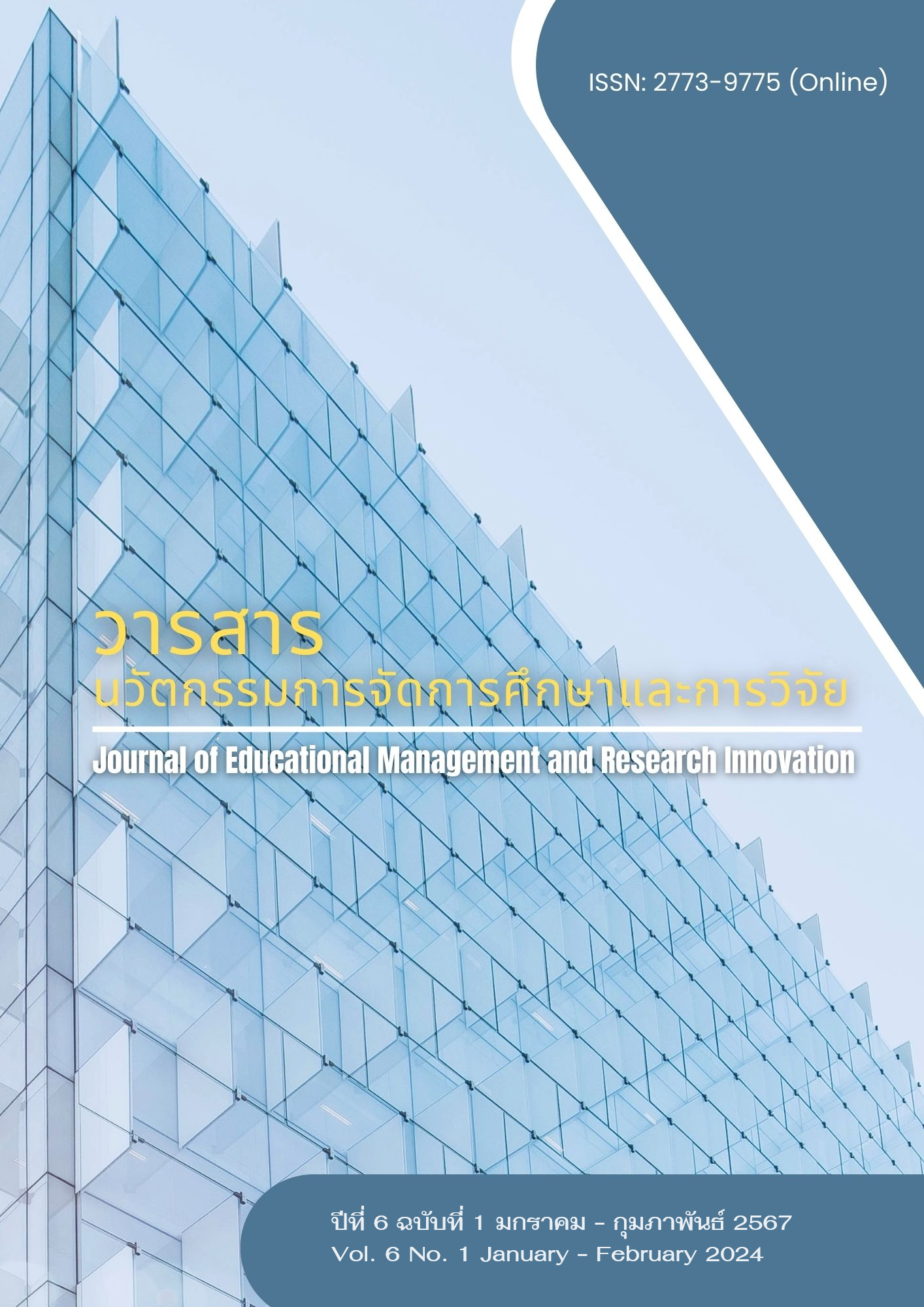กลยุทธ์การจัดการศึกษาเพื่อลดภาวะเครียดและซึมเศร้าจากการเรียนสำหรับนักศึกษาในสถาบันอุดมศึกษา จังหวัดเชียงใหม่
Main Article Content
บทคัดย่อ
บทความนี้มีวัตถุประสงค์ 1) เพื่อวิเคราะห์ภาวะเครียดและซึมเศร้าจากการเรียน 2) เพื่อพัฒนากลยุทธ์การจัดการศึกษาเพื่อลดภาวะเครียดและซึมเศร้า และ 3) เพื่อนำเสนอกลยุทธ์การจัดการศึกษาเพื่อลดภาวะเครียดและซึมเศร้าจากการเรียนของนักศึกษาในสถาบันอุดมศึกษา จังหวัดเชียงใหม่ เป็นการวิจัยแบบผสมผสาน เครื่องมือที่ใช้ ได้แก่ แบบสอบถามและแบบสัมภาษณ์ พื้นที่วิจัย ได้แก่ สถาบันการศึกษาในจังหวัดเชียงใหม่ 2 แห่ง กลุ่มตัวอย่าง คือ นิสิต นักศึกษา จำนวน 337 คน และผู้ให้สัมภาษณ์ จำนวน 15 รูป/คน วิเคราะห์ข้อมูลด้วยโปรแกรมคอมพิวเตอร์สำเร็จรูป และการวิเคราะห์เชิงเนื้อหา สถิติที่ใช้ ได้แก่ ร้อยละ ค่าเฉลี่ย และส่วนเบี่ยงเบนมาตรฐาน
ผลการศึกษาพบว่า 1) ภาวะเครียดและซึมเศร้าจากการเรียน พบว่า นักศึกษามีภาวะเครียดและซึมเศร้าจากการเรียนอยู่ในระดับปานกลาง ปัจจัยที่ทำให้เกิดความเครียด ได้แก่ (1) การติดต่อกับหน่วยงานต่าง ๆ (2) อาจารย์คาดหวังด้านวิชาการ และสั่งงานมากเกินไป (3) กลุ่มเพื่อน มีความขัดแย้งทางความคิด (4) อาคารสถานที่ ไม่เอื้อต่อการจัดการเรียนการสอน (5) กฎ ระเบียบ ข้อบังคับ ไม่ยืดหยุ่น (6) กิจกรรมการเรียนที่เคร่งเครียดเกินไป และ (7) ปัญหาด้านครอบครัว 2) การพัฒนากลยุทธ์การจัดการศึกษาเพื่อลดภาวะเครียดและซึมเศร้า ประกอบด้วย 5 ประเด็น (1) พัฒนาขั้นตอน กระบวนการ และวิธีการให้บริการ (2) พัฒนนาอาจารย์ (3) พัฒนากิจกรรมการเรียนการสอน (4) พัฒนาสภาพแวดล้อม และ (5) พัฒนาสิ่งสนับสนุนการเรียน 3) กลยุทธ์การจัดการศึกษาเพื่อลดภาวะเครียดและซึมเศร้า ได้แก่ สถาบันการศึกษาปรับปรุงกระบวนและวิธีการให้บริการ ปรับเปลี่ยนกฎ ระเบียบ ข้อบังคับ อาจารย์มีมนุษยสัมพันธ์ที่ดี ให้คำปรึกษาที่ดี กิจกรรมการเรียนที่เหมาะสมกับผู้เรียน และให้ความสำคัญกับความแตกต่างระหว่างบุคคล สภาพแวดล้อมเอื้อต่อการเรียน และอุปกรณ์มีประสิทธิภาพ
Article Details

อนุญาตภายใต้เงื่อนไข Creative Commons Attribution-NonCommercial-NoDerivatives 4.0 International License.
เอกสารอ้างอิง
กมลาศ ภูวชนาธิพงศ์ และคณะ. (2564). นวัตกรรมสุขภาวะวิถีพุทธและพุทธจิตวิทยาบำบัดเพื่อลดปัจจัยเสี่ยง ภาวะซึมเศร้าของเยาวชน. วารสาร มจร อุบลปริทรรศน์, 6(2), 531-542.
กรมสุขภาพจิต. (ตุลาคม 2561). รายงานประจำปีกรมสุขภาพจิต. กระทรวงสาธารณสุข. https://dmh.go.th/ download/Ebooks/Annual_report_2018.pdf
กฤตพัทธ์ ฝึกฝน และคณะ. (2561). ปัจจัยที่มีความสัมพันธ์กับความเครียดและการจัดการกับความเครียดของนักศึกษาพยาบาล ในการขึ้นฝึกปฏิบัติทางการพยาบาลครั้งแรกบนหอผู้ป่วย. วารสารการพยาบาลการสาธารณสุขและการศึกษา, 19(1), 161-182.
กฤติยา แก้วมณี และ เฟื่องอรุณ ปรีดีดิลก. (2563). แนวทางการจัดกระบวนการเรียนรู้เพื่อแก้ปัญหาความเครียดด้านการเรียนของนักเรียนมัธยมศึกษาในกรุงเทพมหานคร. วารสารอิเล็กทรอนิกส์ทางการศึกษา, 15(1), 1-12.
จุฑามาศ เหลืองธานี, สิน งามประโคน และพระมหาสมบัติ ธนปญฺโญ. (2561). แนวทางการลดความเครียดของครูและบุคลากรทางการศึกษากลุ่มเครือข่ายส่งเสริมประสิทธิภาพการจัดการศึกษาที่ 6 สำนักงานเขตพื้นที่การศึกษาประถมศึกษาปทุมธานี เขต 1. วารสารครุศาสตร์ปริทรรศน์ คณะครุศาสตร์ มหาวิทยาลัยมหาจุฬาลงกรณราชวิทยาลัย, 5(2), 30-37.
ดวงใจ วัฒนสินธุ์. (2559). การป้องกันภาวะซึมเศร้าในวัยรุ่น: จากหลักฐานเชิงประจักษ์สู่การปฏิบัติ. วารสารคณะพยาบาลศาสตร์ มหาวิทยาลัยบูรพา, 24(1), 1-12.
ทิวาพร ฟูเฟื่อง และกัญญาวีร์ โมกขาว. (2562). ปัจจัยที่มีความสัมพันธ์กับความเครียดของนักศึกษาพยาบาลชั้นปีที่ 1 สถาบันอุดมศึกษาในกำกับของรัฐและเอกชน. วารสารพยาบาลทหารบก, 20(3), 373-382.
นิธิสนี รุจิรังสีเจริญ และคณะ. (2564). ปัจจัยที่สัมพันธ์กับระดับความเครียดของนักเรียนระดับมัธยมศึกษา. วารสารสมาคมจิตแพทย์แห่งประเทศไทย, 66(1), 53-68.
เบญจพร ตันตสูติ. (25 กรกฎาคม 2560). เป็นเด็กก็เครียดได้นะ. มติชน ออนไลน์. https://www.matichon. co.th/lifestyle/news_610320
ภุชงค์ เหล่ารุจิสวัสดิ์. (9 มีนาคม 2561). สื่อสารให้เข้าใจความเครียดในเด็กวัยรุ่น. จุฬาลงกรณ์มหาวิทยาลัย. https://www.chula.ac.th/cuinside/7625/
มาโนช หล่อตระกูล. (9 เมษายน 2557). โรคซึมเศร้าโดยละเอียด. คณะแพทยศาสตร์โรงพยาบาลรามาธิบดี มหาวิทยาลัยมหิดล.
https://med.mahidol.ac.th/ramamental/generalknowledge/general/ 09042014-1017
จิตริน ใจดี. (10 เมษายน 2562). ปรับระบบความคิด ลดวิกฤติการฆ่าตัวตาย. โรงพยาบาลกรุงเทพ. https://www.bangkokhospital.com/content/attitude-adjustment-for-suicide-prevention
โรงเรียนสุเหร่าลาดพร้าว. (ตุลาคม 2562). คู่มือการจัดการความเครียด สำหรับผู้ปฏิบัติงานสอน. สำนักงานเขตวังทองหลาง.
https://webportal.bangkok.go.th/upload/user/00000097/Knowledge/School/stressful %20book.pdf
วิมลวรรณ ปัญญาว่อง และรัตนศักดิ์ สันติธาดากุล. (2563). ความชุกของภาวะซึมเศร้าและความเสี่ยงฆ่าตัวตายในวัยรุ่นไทย: การสำรวจโรงเรียนใน 13 เขตสุขภาพ. วารสารสุขภาพจิตแห่งประเทศไทย, 28(2), 136-146.
สายฝน สีนอเพีย และรุจิรา ดวงสงค์. (2564). ปัจจัยที่มีความสัมพันธ์กับความเครียดและภาวะซึมเศร้าในนักศึกษาระดับปริญญาตรี ชั้นปีที่ 1 มหาวิทยาลัยขอนแก่น. วารสารวิจัยสาธารณสุขศาสตร์มหาวิทยาลัยขอนแก่น, 12(3), 10-23.
สำนักงานปลัดกระทรวงสาธารณสุข. (1 พฤศจิกายน 2563). รายงานการเข้าถึงบริการของผู้ป่วยโรคซึมเศร้าปีงบประมาณ 2564 เดือน ตุลาคม 2563. กระทรวงสาธารณสุข. https://www.thaidepression.com/ www/report/main_report/pdf/ahb-10-20_mix_HDC.pdf
สิทธิพร เกษจ้อย. (2564). การลดความเครียดและพฤติกรรมการจัดการความเครียดของกลุ่มเกษตรกรที่เป็นสมาชิกธนาคารเพื่อการเกษตรและสหกรณ์การเกษตร ตำบลบ้านฝาง อำเภอกระนวน จังหวัดขอนแก่น. วารสารวิทยาลัยสงฆ์นครลำปาง, 10(1), 89-100.
สิรินิตย์ พรรณหาญ, บุญมี พันธุ์ไทย และ กมลทิพย์ ศรีหาเศษ. (2561). ปัจจัยที่มีผลต่อความเครียดในการเรียนของนักศึกษาแพทย์ชั้นปีที่ 4-6 คณะแพทยศาสตร์โรงพยาบาลรามาธิบดี มหาวิทยาลัยมหิดล. Veridian E-Journal, Silpakorn University (Humanities, Social Sciences and Arts), 11(3), 2579-2593.
อรพรรณ ลือบุญธวัชชัย และพีรพนธ์ ลือบุญธวัชชัย. (2553). การบำบัดรักษาทางจิตสังคมสำหรับโรคซึมเศร้า. จุฬาลงกรณ์มหาวิทยาลัย.
Beck, J. S. (2011). Cognitive Behavior Therapy: Basics and Beyond. New York: Guilford.
Dorland, N. A. (1994). Dorland’s Illustrated Medical Dictionary. Philadelphia: W.B. Sauders.
Farmer, R. E, Lym, H. M., & Reinhold, W. H. (1984). Stress Management for Human Services. Beverly Hills: Stage Publications.
Miller, B. F., & Keane, C. B. (1972). Encyclopedia and Dictionary of Medicine and Nursing. Philadelphia: W. B. Saunders.
Selye, H. (1956). The Stress of Life. New York: McGraw-Hill.


